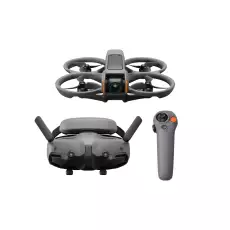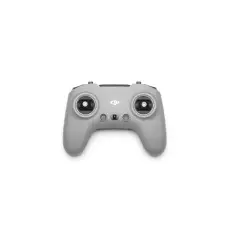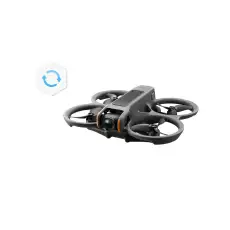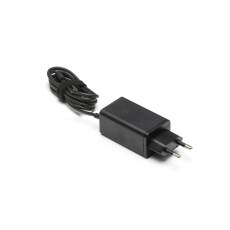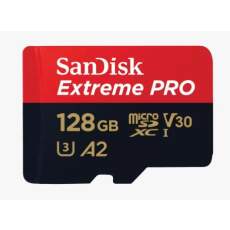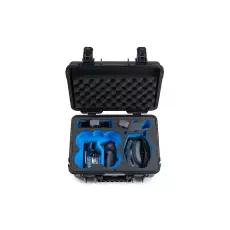In the Box:
1x Avata 2
1x RC Motion 3
1x RC Motion 3 Lanyard
1x Goggles 3
1x Goggles 3 Foam Padding
1x Goggles 3 Additional Forehead Pad
1x Goggles 3 -2.0D Corrective Lenses (Pair)
1x USB-C OTG Cable
1x Avata 2 Intelligent Flight Battery
2x Avata 2 Propellers (Pair)
8x Avata 2 Propeller Screw
1x Screwdriver
1x Avata 2 Gimbal Protector
1x Type-C to Type-C PD Cable
Aircraft
Takeoff Weight
Approx. 377 g
Dimensions
185×212×64 mm (L×W×H)
Max Ascent Speed
6 m/s (Normal mode)
9 m/s (Sport mode)
Max Descent Speed
6 m/s (Normal mode)
9 m/s (Sport mode)
Max Horizontal Speed (near sea level, no wind)
8 m/s (Normal mode)
16 m/s (Sport mode)
27 m/s (Manual mode)*
* No faster than 19 m/s with the Manual mode in the EU regions.
Max Takeoff Altitude
5000 m
Measured in a windless environment when taking off from an altitude of 5000 m and ascending vertically by 500 m, using Sport mode, and from 100% battery level until 20%. Data is for reference only. Always pay attention to reminders on the goggles' screens during your flight.
Max Flight Time
Approx. 23 mins
Measured when flying forward at a speed of 21.6 kph in a windless environment at sea level, with camera parameters set to 1080p/30fps, video mode off, and from 100% battery level until 0%. Data is for reference only. Always pay attention to reminders on the goggles' screens during your flight.
Max Hovering Time
Approx. 21 mins
Measured when hovering in a windless environment at sea level, with camera parameters set to 1080p/30fps, video mode off, and from 100% battery level until 0%. Data is for reference only. Always pay attention to reminders on the goggles' screens during your flight.
Max Flight Distance
13.0 km
Measured when flying forward at a speed of 43.2 kph in a windless environment at sea level, with camera parameters set to 1080p/30fps, video mode off, and from 100% battery level until 0%. Data is for reference only. Always pay attention to reminders on the goggles' screens during your flight.
Max Wind Speed Resistance
10.7 m/s (Level 5)
Operating Temperature
-10° to 40° C (14° to 104° F)
Global Navigation Satellite System
GPS + Galileo + BeiDou
Hovering accuracy range
Vertical:
±0.1 m (with vision positioning)
±0.5 m (with GNSS positioning)
Horizontal:
±0.3 m (with vision positioning)
±1.5 m (with GNSS positioning)
Internal Storage
46 GB
Camera
Image Sensor
1/1.3-inch image sensor
Effective Pixels: 12 MP
Lens
FOV: 155°
Format Equivalent: 12 mm
Aperture: f/2.8
Focus: 0.6 m to ∞
ISO Range
100-25600 (Auto)
100-25600 (Manual)
Shutter Speed
Video: 1/8000-1/30 s
Photo: 1/8000-1/50 s
Max Image Size
4000×2256 (16∶9)
4000×3000 (4∶3)
Still Photography Mode
Single shot
Photo Format
JPEG
Video Resolution
4K (4∶3): 3840×2880@30/50/60fps
4K (16∶9): 3840×2160@30/50/60fps
2.7K (4∶3): 2688×2016@30/50/60fps
2.7K (16∶9): 2688×1512@30/50/120fps
1080p (4∶3): 1440×1080@30/50/120fps
1080p (16∶9): 1920×1080@30/50/120fps
Video Format
MP4 (H.264/H.265)
Max Video
Bitrate 130 Mbps
Supported File System
exFAT
Color Mode
Standard
D-Log M
Camera FOV
Supports normal mode, wide-angle mode, and ultra-wide-angle mode.
EIS
Supports RockSteady 3.0+ and HorizonSteady
Can be disabled*
* When stabilization is turned off, footage captured with the wide-angle view supports offline stabilization Gyroflow.
Gimbal
Stabilization
Single-axis mechanical gimbal (tilt)
Mechanical Range
Tilt: -95° to 90°
Controllable Range
Tilt: -85° to 80°
Max Control Speed (tilt)
100°/s
Angular Vibration Range
±0.01°
Electronic Roll Axis
Real-time screen correction is unavailable during recording, but can be applied to the footage recorded on the drone.
Sensing
Sensing Type
Downward and backward visual positioning
Downward
ToF Effective Measurement Height: 10 m
Precise Hovering Range: 0.3-10 m
Measurement Range: 0.3-20 m
FOV: Horizontal 78°, Vertical 78°
Backward
Measurement Range: 0.5-20 m
FOV: Horizontal 78°, Vertical 78°
Operating Environment
Diffuse reflective surfaces with discernible patterns, diffuse reflectivity > 20% (such as concrete pavement)
Adequate lighting (lux > 15, normal indoor lighting conditions)
Video Transmission
Video Transmission System O4
Live View Quality 1080p@30/50/60/100fps
Operating Frequency
2.400-2.4835 GHz
5.170-5.250 GHz*
5.725-5.850 GHz*
* 5.170-5.250 GHz and 5.725-5.850 GHz can be used only in countries and regions where permitted by local laws and regulations.
Transmitter Power (EIRP)
2.4 GHz:
<33 dBm (FCC)
<20 dBm (CE/SRRC/MIC)
5.1 GHz:
< 23 dBm (CE)
5.8 GHz:
<33 dBm (FCC)
<30 dBm (SRRC)
< 14 dBm (CE)
Communication Bandwidth
Max 60 MHz
Max Transmission Distance (unobstructed, free of interference)
FCC: 13 km (subject to the aircraft's max flight distance)
CE: 10 km
SRRC: 10 km
MIC: 10 km
Measured in an unobstructed outdoor environment free of interference. The above data shows the farthest communication range for one-way, non-return flights under each standard. Always pay attention to RTH reminders on the goggles screen during your flight.
Max Transmission Distance (unobstructed, with interference)
Strong Interference: Urban landscape, approx. 1.5-4 km
Medium Interference: Suburban landscape, approx. 4-10 km
Low Interference: Suburb/seaside, approx. 10-13 km
Data tested under FCC standard in unobstructed environments with typical interference. Used for reference purposes only and provides no guarantee for actual transmission distance.
Max Transmission Distance (obstructed, with interference)
Low Interference and Obstructed by Buildings: approx. 0-0.5 km
Low Interference and Obstructed by Trees: approx. 0.5-3 km
Data tested under FCC standard in environments with typical low interference. Used for reference purposes only and provides no guarantee for actual transmission distance.
Max Download Speed
Wi-Fi: 30 MB/s*
* Measured in a laboratory environment with little interference in countries/regions that support both 2.4 GHz and 5.8 GHz. Download speeds may vary depending on the actual conditions.
Lowest Latency
With DJI Goggles 3:
1080p/100fps Video Transmission Quality: 24 ms
1080p/60fps Video Transmission Quality: 40 ms
Max Video Bitrate
60Mbps
Antennas
4 antennas, 2T4R
Wi-Fi
Protocol
802.11a/b/g/n/ac
Operating Frequency
2.400-2.4835 GHz
5.725-5.850 GHz
Transmitter Power (EIRP)
2.4 GHz:
<20 dBm (FCC/CE/SRRC/MIC)
5.8 GHz:
<20 dBm (FCC/SRRC)
< 14 dBm (CE)
Wi-Fi
Protocol
802.11a/b/g/n/ac
Operating Frequency
2.400-2.4835 GHz
5.725-5.850 GHz
Transmitter Power (EIRP)
2.4 GHz:
<20 dBm (FCC/CE/SRRC/MIC)
5.8 GHz:
<20 dBm (FCC/SRRC)
< 14 dBm (CE)
Bluetooth
Protocol
Bluetooth 5.0
Operating Frequency
2.400-2.4835 GHz
Transmitter Power (EIRP)
<10 dBm
Intelligent Flight Battery
Capacity
2150 mAh
Weight
Approx. 145 g
Standard Voltage
14.76 V
Max Charging Voltage
17 V
Battery Type
Li-ion
Energy
31.7 Wh@0.5C
Charging Temperature
5° to 40° C (41° to 104° F)
Charging Time
With Charging Hub (60W max charging power):
From 0 to 100%: approx. 45 min
From 10 to 90%: approx. 30 min
Directly Charging the Drone (30 W max charging power):
From 0 to 100%: approx. 88 min
From 10 to 90%: approx. 60 min
Charger
Recommended Charger
DJI 65W Portable Charger
DJI 65W Car Charger
USB Power Delivery charger
Battery Charging Hub
Input
5-20 V, max 3 A
Output (power accumulation)
Max 65 W
Output (charging)
Max 17 V
Output (USB)
5 V, 2 A
Charging Type
Three batteries charged in sequence.
Compatibility
DJI Avata 2 Intelligent Flight Battery
Storage
Recommended microSD Cards
SanDisk Extreme PRO 32GB U3 A1 V30 microSDHC
Lexar Professional 1066x 64GB U3 A2 V30 microSDXC
Lexar Professional 1066x 128GB U3 A2 V30 microSDXC
Lexar Professional 1066x 256GB U3 A2 V30 microSDXC
Lexar Professional 1066x 512GB U3 A2 V30 microSDXC
Kingston CANVAS Go! Plus 64GB U3 A2 V30 microSDXC
Kingston CANVAS Go! Plus 128GB U3 A2 V30 microSDXC
Kingston CANVAS React Plus 64GB U3 A1 V90 microSDXC
Kingston CANVAS React Plus 128GB U3 A1 V90 microSDXC
Kingston CANVAS React Plus 256GB U3 A1 V90 microSDXC
Samsung EVO Plus 512GB U3 A2 V30 microSDXC
DJI FPV Remote Controller 3
Max Operating Time
Approx. 10 hours
Operating Temperature
-10° to 40° C (14° to 104° F)
Charging Temperature
0° to 50° C (32° to 122° F)
Charging Time
2 hours
Charging Type
5 V, 2 A
Battery Capacity
2600 mAh
Weight
Approx. 240 g
Dimensions
165×119×62 mm (L×W×H)
Operating Frequency
2.400-2.4835 GHz
Transmitter Power (EIRP)
2.400 GHz:
<26 dBm (FCC)
<20 dBm (CE/SRRC/MIC)

